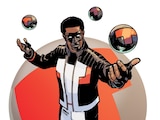Sadly, the Man of Steel has been largely missing from DC’s ongoing comics this past month, something that’s particularly hard considering how many of us could use a little hope right now. But as you don’t need me to tell you, Superman exists far beyond the comic book page. A beloved symbol of justice and fighting for what’s right for over eighty years, you can find Superman stitched into the very fabric of our lives. He’s on TV and in movies. His symbol is seen on clothing and works of pop art all throughout the world. Children learn his name and play with his toys before they’re even in school, meaning that for many kids, “S” is very likely the first letter they learn.
Superman is there whenever you need him. As a character and as a cultural icon, you’re never really without him, wherever you may find yourself, and in whatever desperate circumstances may have befallen you. This has been true for generations. Our parents and grandparents have been entertained by Superman’s adventures. Like many of us, they’ve pinned a blanket around their neck and hopped around the furniture, as if those couches and chairs were tall buildings to be leapt in a single bound.

In short, Superman may not be of our world, but there’s little doubt he’s made his mark on it. And just because he’s a fictional character doesn’t mean he hasn’t helped bring about real-world change.
One instance of this has to do with the classic pro-diversity poster that has become a viral social media staple. Commissioned in 1949 for a brown paper book cover, the image has—against all odds—endured for over 70 years largely due to the power, importance and relevance of its message.

However, perhaps the best example took place a few years later, on The Adventures of Superman radio show. In the decades before TV, radio was America’s most popular form of entertainment and The Adventures of Superman was one of the most popular shows on it. Voiced by Clayton “Bud” Collyer, this early version of Superman took down both classic and new villains, and introduced things to Superman’s mythos like the Daily Planet, kryptonite and the Man of Steel’s ability to fly.
In 1946, a 16-part storyline called “The Clan of the Fiery Cross” debuted in which Superman protected a family of Chinese immigrants from a group of hooded white supremacists. The storyline won all manner of acclaim and was popular to boot, and is often credited with tarnishing the image of the real-life Ku Klux Klan, which at the time was experiencing a resurgence. After the storyline aired, the group’s momentum fizzled and its numbers took a hit.

This iconic—and quite possibly world-changing—storyline has recently been reimagined through a Young Adult lens by Eisner winner and National Book Award finalist Gene Luen Yang and the Japanese art team known as Gurihiru. Superman Smashes the Klan is the latest book in DC’s YA line, though I’d argue its appeal is broad—you don’t need to be a young adult or a YA fan to find a lot to enjoy in the story. Yang and Gurihiru tap into who Superman is beneath the flashy costume and powers, reminding fans that Kal-El’s story is very much an immigrant’s one as much as it is a superhero’s. It’s a story that Yang, the child of two Taiwanese immigrants, knows very well.
I doubt it’s much of a spoiler to say that Superman manages to put a stop to the bigots that are terrorizing the Lee family. It’s right there in the title after all. But the journey getting there, which involves Superman coming to accept things about himself that make him different than other Americans, is a compelling and rousing one. It also calls to mind Superman’s anti-hate poster, particularly when the hero is confronting the leader of the book’s Klan of the Fiery Kross.

For Superman fans and comic fans in general, Superman Smashes the Klan is a must-read. It’s an example of what comics can achieve and a reminder of what it has achieved. And it’s, sadly, still very necessary.
While Yang’s story, much like the radio serial it was inspired by, is set in the past, there’s a modern-day urgency to it. We may never get tired of seeing Superman battle Brainiac or match wills with Lex Luthor, but the villains of Superman Smashes the Klan are ones he shouldn’t still have to fight in 2020. Yet as nearly anyone could tell you, the scourge of hatred and racism is still very much alive today.
It’s worth mentioning that Superman isn’t able to defeat the Klan of the Fiery Kross without the help of Roberta and Tommy Lee, the family’s two children. Both kids contribute in their own ways, which gets back to what I was saying at the beginning of this column. Whenever things feel hopeless and challenges seem insurmountable, you can always look to Superman as inspiration and even a force for change. But we’re the ones who need to bring it about. Superman can’t smash anything without us.
Tim Beedle covers movies, TV and comics for DCComics.com, writes our monthly Superman column, "Super Here For...", and is a regular contributor to the Couch Club, our weekly television column.




















